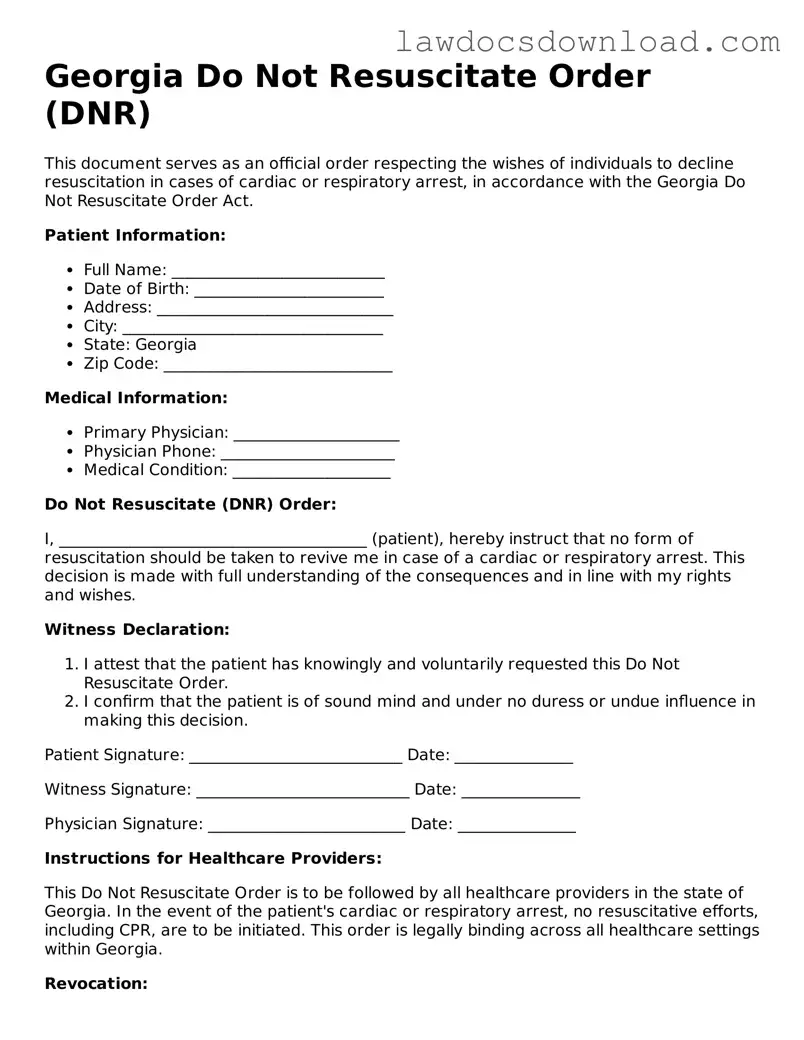The Georgia Do Not Resuscitate (DNR) Order is essentially a legal document that communicates a patient's wish not to undergo CPR (Cardiopulmonary Resuscitation) if their heart stops or they stop breathing. This document has similarities with other forms that also deal with medical decisions and personal choices about healthcare. Each of these documents serves a unique purpose, but they all share the common goal of ensuring a person’s healthcare wishes are known and respected.
Another document similar to the Georgia DNR is the advance directive. An advance directive is a broader document that can include a living will and a healthcare power of attorney. Like a DNR, it outlines a person's wishes regarding medical treatment if they are unable to communicate those wishes themselves. However, it covers more extensive scenarios and treatments beyond CPR, including life support and other life-saving or sustaining treatments.
A living will, as part of an advance directive, specifically addresses the types of medical care a person desires at the end of their life. It closely resembles a DNR in its purpose to direct medical professionals on whether to administer or withhold life-sustaining treatments. While a DNR specifically focuses on CPR, a living will can include wishes regarding the use of ventilators, feeding tubes, and other procedures.
A healthcare power of attorney (POA) is a legal document that designates someone else to make medical decisions for a person if they become unable to make those decisions themselves. While it differs in purpose from a DNR, which articulates a specific medical decision, both documents are instrumental in planning for medical care when a person cannot express their wishes.
The POLST (Physician Orders for Life-Sustaining Treatment) form is another document that has a similar objective to the DNR. It is more comprehensive and is designed to ensure that seriously ill or frail patients can have their treatment preferences followed across different settings of care. The POLST form includes instructions on CPR, ventilation, antibiotics, and feeding tubes, making it a broader directive than a DNR.
A Medical Orders for Scope of Treatment (MOST) form is akin to a POLST form and, by extension, shares similarities with a DNR. It is typically used for individuals with serious illnesses and specifies which medical treatments and interventions a person wants or does not want, including CPR, much like a DNR.
A do-not-intubate (DNI) order is specifically directed towards refusing intubation and mechanical ventilation. While it has a narrower focus compared to a DNR, both documents express a decision to avoid specific life-sustaining treatments. A DNI is often considered alongside a DNR in end-of-life planning.
The MOLST (Medical Orders for Life-Sustaining Treatment) form, similar to POLST and MOST forms, is another medical order that applies to patients with serious health conditions. It outlines a variety of medical interventions, including CPR, much like a DNR. However, it is more detailed and covers a broader range of medical treatments and decisions.
An emergency medical ID is a personal identification that lists critical health information, including a person’s DNR status. While it is not a legal document, it serves a similar purpose in emergencies by quickly conveying important health care preferences, such as the wish to avoid CPR, to first responders and medical personnel.
Last but not least, a Five Wishes document is an advance directive that goes beyond the medical and legal aspects of end-of-life planning to include personal, emotional, and spiritual wishes. While broader in scope, it encompasses the concept of a DNR by allowing individuals to declare their wishes about life-sustaining treatment.
